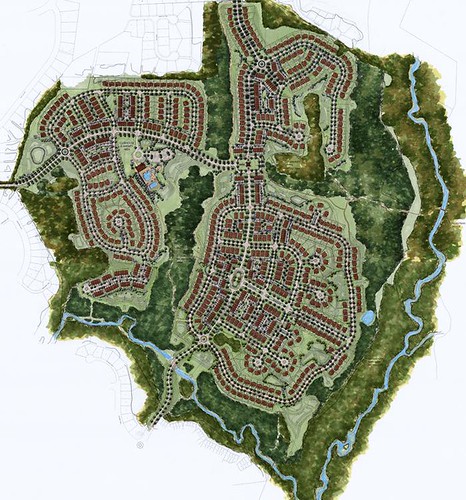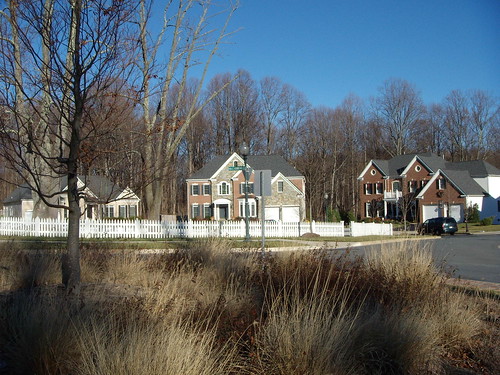
Located at the end of a long driveway off Layhill Road, Indian Spring Country Club looked exclusive, but it opened its doors to the community, hosting everything from fundraisers to political events. It was the site of my high school's junior and senior proms, where you could hang out on the deck overlooking the fairways (while all the "popular kids" danced and made out inside) feeling like you owned the place. Indian Spring was cheaper than the area's more exclusive country clubs, and for decades served as the center of Jewish social life in Montgomery County.
Indian Spring has been closed for nearly three years now as construction begins on Poplar Run, a 773-home planned community that will take its place. Photos by Flickr user martymix, who documented the course while open and after it closed (via breaking in) reveal how quickly the grounds 50's-era clubhouse deteriorated from lack of use. While Indian Spring's history may be gone, its culture of openness will remain in the way Poplar Run has been laid out to encourage connections within and outside the new development.
 The old country club's layout doesn't easily lend itself to housing, with just a long, narrow driveway leading from Layhill Road. Three of the four neighboring subdivisions have streets that dead-end at the club property, all of which will eventually continue into Poplar Run. The civic associations have been very upset about this, notably Tivoli to the south, which enlisted the help of their state delegates to push the argument that it would clog their streets and make it unsafe for children to play outside.
The old country club's layout doesn't easily lend itself to housing, with just a long, narrow driveway leading from Layhill Road. Three of the four neighboring subdivisions have streets that dead-end at the club property, all of which will eventually continue into Poplar Run. The civic associations have been very upset about this, notably Tivoli to the south, which enlisted the help of their state delegates to push the argument that it would clog their streets and make it unsafe for children to play outside.Tivoli was built in the 1980's. It's a typical suburban subdivision in that you don't see a single house facing Tivoli Lake Boulevard, the main street which will also become the spine of Poplar Run. Behind the trees on either side of the road, everyone's tucked away in a little pod, efficiently segregated by home style and income level. (And each pod has its own name: Tivoli Woods, Tivoli Villas, and Tivoli Estates for the largest homes.) It's a gorgeous neighborhood, but one that sends a message strong and clear that outsiders aren't welcome here.

Though it'll be right next door, the layout (click here for a larger version) of Poplar Run couldn't be more different. There are only a handful of culs-de-sac; the majority of homes face through streets that connect to each other and to the surrounding neighborhoods. Townhomes and single-family homes share the same block, integrating households with different incomes. A plurality of homes put parking in the back, creating more pedestrian-friendly streets. The subdivision is littered with small "pocket parks" and vistas of the adjacent Northwest Branch and Bel Pre Creek.
At the center is a public square, a space that will hopefully encourage informal gatherings. Along with a series of roundabouts - including one in Tivoli, part of a compromise used to win that neighborhood's support - it'll also help slow down traffic, discouraging cut-throughs. Winchester Homes has even offered to pay for an extension of Ride-On Route 31 into the development, providing a one-seat ride to Glenmont and Wheaton.

It goes against the suburban status quo to say that connecting your cul-de-sac to mine might reduce traffic. After all, there's already no traffic on a cul-de-sac because it doesn't go anywhere. But the traffic ends up somewhere - on overburdened arterial roads like Randolph and Layhill, which have to carry local trips along with through trips as well. In an area less than a mile from the Glenmont metro station and clogged with commuters heading west to Rockville and south to the District, requiring people to get on Layhill Road for a gallon of milk is a waste of road capacity.
It's better to keep local traffic on local streets and allow major roads to carry the cars they were built to handle. The network of connecting strets that Poplar Run completes allows residents of all four neighboring subdivisions to travel to parks, schools, stores and even the Metro while barely using Randolph, Layhill or Bonifant roads. And it's not just for cars: more interconnected streets mean more routes for pedestrians and bicyclists, too, who especially benefit from alternatives to wide, unsafe arterials.
In this built-up area, three hundred acres doesn't just appear out of nowhere, so when an opportunity comes to redevelop such a large property, it has to be done right. I'd argue that many of the issues East County grapples with - from traffic to tension between different socioeconomic groups - would be solved if our neighborhoods actually connected to each other. We cocoon ourselves in our private subdivisions and wonder why the world outside them is so unpleasant. It's because we've forgotten to consider the common good, and how individual decisions can have a positive or negative effect on others.
While Winchester Homes had their own reasons, both altruistic and selfish, for making the choices they did in Poplar Run, they'll have benefits far beyond this community when completed.

4 comments:
I've titled the Indian Spring 09 Photos so you can get some sense of the holes... I was driving by one day and the gates were open - so I drove on in! Still miss Indian Spring.
Dan, you are absolutely right about the need for local street connections to avoid the problems associated with pushing every local trip onto arterials. It would also be great if the Indian Spring redevelopment would include a trail connection from the Mathew Henson trail (which begins just to the northwest and goes all the way to Rock Creek Park) to the Northwest Branch trail on the eastern edge of the redeveloped area and Wheaton Regional Park/Sligo Creek trail (which extend all the way to Prince George's County).
Due to size constraints imposed on comments here -- way to dumb-down a blog, Dan -- my response to this is here.
And don't forget, most of those neighborhoods rather desperately don't want to be tied together other than for foot/bike traffic, which is already much the case.
It's worth noting that one end of the Matthew Henson Trail is in fact already in that neighborhood, on Alderton Road just north of the Indian Spring Country Club Courthouse.
And it appears from actually looking at a map as well as the site-plan, that Alderton Road will join and change names to become Poplar Run Drive, which will more-or-less cross Randolph Road to become Kemp Mill Road.
Would be interested to know of Alderton Road is a public street, or whether it is privately controlled by the adjacent landowners.
Post a Comment